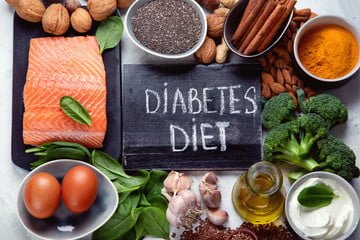Taking care of yourself when you have diabetes means paying attention to what you eat and staying active. This helps keep your blood sugar at the right level. It’s important to follow a healthy eating plan and move your body regularly.
To manage your blood sugar, you need to balance what you eat, your physical activity, and any medicine you might be taking. The choices you make about food, how much you eat, and when you eat all play a role in keeping your blood sugar in check.
It might feel tough to make big changes, but you can start with small steps. You don’t have to do it alone – your family, friends, and healthcare team can offer support.
Eating well and staying active can bring many benefits:
- Keep your blood sugar, blood pressure, and cholesterol in the right range.
- Manage your weight or keep it at a healthy level.
- Avoid or delay problems related to diabetes.
- Feel good and have more energy.
Remember, every little effort counts towards a healthier life!
What is diabetes?
Diabetes happens when the sugar levels in your blood, called blood glucose, are too high. This sugar comes from the food you eat, and your body needs it for energy. Insulin, a hormone, helps the sugar get into your cells.
In type 1 diabetes, your body doesn’t make insulin. In type 2 diabetes, your body either doesn’t make enough insulin or can’t use it properly. Without sufficient insulin, sugar stays in your blood, leading to high blood sugar levels.
Prediabetes means your blood sugar is higher than normal but not quite diabetes yet. If you have prediabetes, you’re more likely to develop type 2 diabetes.
How do the foods affect blood sugar?
The sugar in your blood mainly comes from foods with carbohydrates, also known as “carbs.” Examples include candy, soda, bread, tortillas, and white rice. Eating more carbs tends to raise your blood sugar.
Whether you have type 1 or type 2 diabetes, making smart food choices is crucial to keep your blood sugar at a healthy level. Controlling your blood sugar reduces the risk of serious health issues related to diabetes, like vision problems and heart complications.
If you have prediabetes or are at risk, choosing foods that maintain healthy blood sugar levels can also help prevent type 2 diabetes down the road.
When is the ideal time to have meals While having diabetes?
- Stick to a regular eating routine if your diabetes treatment requires it.
- For others, mealtime can be more flexible, especially if you use certain types of insulin.
- Skipping meals, especially if you take certain medicines, can make your blood sugar too low. Check with your healthcare team about when to eat, and whether it’s wise to have a snack before or after physical activity.
How much to eat with diabetes?
Figuring out the right amount is important for managing your blood sugar and weight. Your healthcare team can guide you on how many calories and how much food is right for you.
1. For weight loss:
If you’re overweight or dealing with obesity, your health team can help you create a plan. The Body Weight Planner is a useful tool to customize your calorie and activity goals to reach and maintain a healthy weight. To shed pounds, focus on eating fewer calories and swapping less healthy foods for lower-calorie, lower-fat, and lower-sugar options.
2. Planning for pregnancy:
If you’re thinking about having a baby, especially with diabetes, being overweight, or obese, it’s a good idea to lose any extra weight before getting pregnant. Check with your healthcare team for advice on planning for pregnancy.
3. Meal planning methods:
Two common ways to plan your meals with diabetes are the plate method and carbohydrate counting (carb counting). Your health team can help you choose the method that works best for you.
4. Plate Method:
This method helps you control portions without counting calories. Just use a 9-inch plate. Fill half with nonstarchy vegetables, one-fourth with protein (like meat), and one-fourth with a grain or starch. Starchy veggies like corn and peas count, too. You can also have a small bowl of fruit, a piece of fruit, and a small glass of milk, as outlined in your meal plan. This method works well for lunch and dinner.
5. Judging Portion Sizes:
You don’t always need fancy tools. Everyday items or your hand can help you figure out portion sizes.
- A serving of meat or poultry is about the size of your palm or a deck of cards.
- For fish, think of a checkbook.
- Cheese? Picture six dice.
- Cooked rice or pasta? Imagine a rounded handful or a tennis ball.
- A pancake or waffle is about the size of a DVD.
- Two tablespoons of peanut butter? Picture a ping-pong ball.
6. Carbohydrate Counting:
Carbs turn into glucose in your body, affecting your blood sugar. Counting them can help manage your levels, especially if you take insulin. It’s not necessary for everyone with diabetes, so your healthcare team can help decide what’s best for you.
Here’s a quick guide:
- Learn which foods have carbs.
- Check the Nutrition Facts label or estimate the grams of carbs in your food.
- Add up the carb grams for each meal and each day.
Most carbs come from things like starches, fruits, milk, and sweets. Focus on limiting carbs with added sugars or refined grains (like white bread and rice). Instead, go for carbs from fruits, veggies, whole grains, beans, and low-fat or nonfat milk.
What to eat if you have diabetes?
The good news is, you can still enjoy your favorite foods, but you might need to eat smaller portions or have them less often. Your healthcare team will help you create a meal plan that fits your needs and tastes.
The key to eating with diabetes is to have a variety of healthy foods from different groups in the right amounts, as suggested by your meal plan. Here are the food groups you should know:
- Vegetables:
- Nonstarchy veggies like broccoli, carrots, greens, peppers, and tomatoes.
- Starchy veggies like potatoes, corn, and green peas.
- Fruits:
- Oranges, melons, berries, apples, bananas, and grapes.
- Grains:
- Half of your grains should be whole grains like wheat, rice, oats, cornmeal, barley, and quinoa. Examples include bread, pasta, cereal, and tortillas.
- Protein:
- Lean meat, chicken or turkey without the skin, fish, eggs, nuts, peanuts, dried beans, certain peas (like chickpeas and split peas), and meat substitutes like tofu.
- Dairy:
- Nonfat or low-fat options like milk (or lactose-free if you’re lactose intolerant), yogurt, and cheese.
Remember to include heart-healthy fats in your diet, which you can find in oils like canola and olive oil, nuts, seeds, heart-healthy fish (like salmon, tuna, and mackerel), and avocados. When cooking, use oils instead of butter, cream, shortening, lard, or stick margarine.
What foods and drinks should you cut back on if you have diabetes?
Limit these foods and drinks:
- Fried foods and things high in bad fats.
- Foods loaded with salt (also called sodium).
- Sweets like baked goods, candy, and ice cream.
- Drinks with added sugars, like juice, regular soda, and sports or energy drinks.
Swap sugary drinks for water. If you enjoy coffee or tea, think about using a sugar substitute.
Keep an eye on alcohol:
- If you drink, do it moderately—no more than one drink a day if you’re a woman, or two if you’re a man.
- Be cautious if you use insulin or certain diabetes medicines, as alcohol can make your blood sugar drop too low, especially if you haven’t eaten recently. Having some food with your drink is a good plan.


